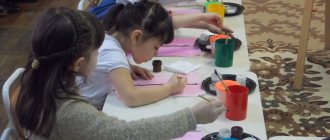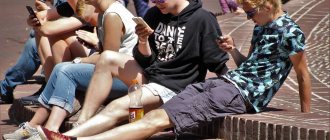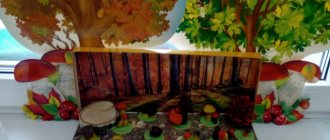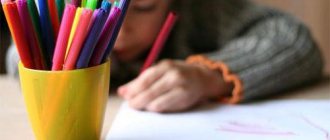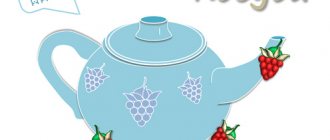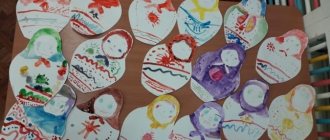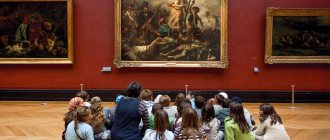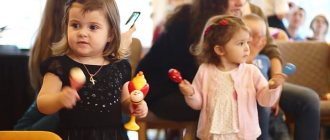The concept and essence of artistic and aesthetic development of preschool children
Definition 1
Artistic and aesthetic development is the process of developing the prerequisites for the value-semantic understanding and perception of works of art, the formation of an aesthetic attitude to the surrounding world and elementary ideas about types of art, the realization of one’s own creative potential.
Artistic and aesthetic activity by its nature is a specific activity in which each child is given the opportunity to reveal his own potential, show his abilities through a specific product of activity (crafts, drawings, applications, etc.).
Note 1
The concept of preschool education sets clear tasks for educators and teachers; the solution provides for the artistic and aesthetic development of preschool children, as well as the development of creativity in them, which is necessary for future life activities.
Are you an expert in this subject area? We invite you to become the author of the Directory Working Conditions
In accordance with the Concept of Preschool Education, a number of requirements are imposed on educators, namely the presence of certain competencies necessary for the comprehensive artistic and aesthetic development of preschool children:
- Ability to establish working relationships with each child based on mutual trust and respect.
- Respectful attitude towards the personality of each student.
- Respect the choices and needs of each student.
In accordance with the Federal State Educational Standard for Preschool Education, artistic and aesthetic activities aimed at the development of a child within the preschool educational institution include:
- Visual activities (drawing, modeling, applique).
- Musical activity, including musical perception (listening to musical works, getting to know musical instruments, learning to play musical instruments, etc.).
- Fiction (listening to works of fiction, reading them, discussing them, etc.).
Recommendations for teachers and educators
Recommendations for the moral and aesthetic education of preschoolers include a number of methods and principles:
- Aesthetics of the environment (live plants, furniture, color scheme for playrooms, cleanliness and order).
- Independent artistic activity (classes in free creativity using decorative and applied arts).
- Classes with a teacher (development of tastes and ideals under the supervision and sensitive guidance of a mentor).
There are some features of aesthetic education of preschool children in preschool educational institutions. Unlike the home environment, creative activity takes place among peers and under the guidance of a competent mentor. This motivates the child to do everything better so that he is praised and distinguished from the rest. If at home a child often gives up at the first failure, then in kindergarten, looking at the example of other children, he will look for ways to cope with the task. Therefore, creative and aesthetic activities should be carried out precisely in preschool educational institutions.
To do this, the teacher must clearly understand what creativity is and what competencies and skills the child should acquire as a result.
Indicators of creative activity (according to I. Lerner):
- the ability to use old knowledge in a new situation without outside help;
- the ability to find and apply new functions of an already known object;
- the ability to see problems in a standard situation;
- the ability to combine previously known methods into new ones.
The teacher should encourage the child for showing independence, and in no case scold if the children, for example, start drawing a bouquet instead of one flower. What is important is a relaxed atmosphere and some relaxation of discipline - let the preschoolers talk, go to the window or stand with toys. Then the aesthetic education of preschoolers will be carried out with joy and inspiration for the child.
Tasks of artistic and aesthetic education of children of different age groups of preschool educational institutions
Tasks of artistic and aesthetic education of children of the younger group of preschool educational institutions:
Finished works on a similar topic
Course work Artistic and aesthetic development of preschool children 430 ₽ Abstract Artistic and aesthetic development of preschool children 270 ₽ Test work Artistic and aesthetic development of preschool children 250 ₽
Receive completed work or specialist advice on your educational project Find out the cost
- Carrying out comprehensive preparation for the perception of artistic works of art.
- Encouraging children to visit cultural and aesthetic places: theater, cinema, museum, exhibition, etc.
- Introduction to decorative activities.
- Familiarization with musical and artistic genres.
- Promoting the development of musical abilities.
- Formation of interest in artistic activities, familiarization with different drawing techniques.
- A retelling of famous works based on illustrations and pictures.
The main tasks of artistic and aesthetic education of children in the middle and senior groups of preschool educational institutions:
- Forming children's interest in various types of art, introducing them to the aesthetic perception of art.
- Introducing children to the professions of an artist, singer, composer, performer, etc.
- Introduction to architecture.
- Consolidating the knowledge acquired in the junior group about books, book illustrations, etc.
- Continued development of interest in visual arts by enriching children’s understanding of the arts
- Continue to develop interest in appliqué, modeling, drawing, etc. Getting to know new techniques.
- Learn to recognize songs while listening to the melody, perform dance moves and play non-musical instruments.
Examples of activities with preschoolers
Aesthetic education of preschoolers is a process organized by a teacher or parents. They use not only a theoretical basis, but also a practical one. Children are engaged in reading fiction, looking at pictures, and also creating objects of art.
Integrated lesson “Fairytale Bird”
Initially, children are introduced to a work about a fairy-tale bird. You can use fiction about the Firebird. The children are read fairy tales and shown pictures describing a magical creature.
Integrated lesson “Fairytale Bird” (application)
Integrated lesson “Fairytale Bird” (plasticine)
After this, they talk with the children. They ask you to give a description of the bird. Children who find it difficult to make contact are asked leading questions. For example, “What color are her feathers?” After the children appreciate the attractiveness of the character, they are invited to make their own Firebird.
Depending on the age of the children, they are given paints or pencils. You can use plasticine. After the material has been distributed, the children are allowed to use their imagination and make their own crafts.
Application “Decorating dishes”
This activity contributes to the development of the child’s creative abilities and develops his sense of beauty. During the activity, perseverance is developed and accuracy is demonstrated.
The teacher prepares handouts in advance:
- Templates for mugs and plates – to choose from.
- Carves patterns or ornaments.
- Selects demonstration material.
This activity can be added to the cycle about folk art. Before practice, children are told about how in the old days it was customary to paint dishes. What significance was attached to patterns? As an example, photographs of folk art are shown.
After theory, they begin practice. Each child is given a piece of utensils and asked to decorate it based on personal taste.
The activity “Decorating dishes” can also be done with plasticine
Draw children's attention to neatness, conciseness of details, and selected colors. You can correct the child a little during work, offer him parts that match the color. At the end of the lesson, they admire the created creations.
Craft for March 8th “Bouquet for Mom”
This activity is suitable both as a creative master class and as an opportunity to make a craft for a specific holiday. To hold the event you will need preliminary preparation. It is necessary to select the material from which children will create bouquets. These can be buttons, scraps of fabric, colored paper, ribbons.
The easiest way to make a bouquet:
- Use colored paper clippings.
- Prepare beautiful templates.
For work, the teacher cuts out beautiful flowers from paper. Be sure to draw the outlines of the plants on a blank sheet of paper so that the child can see where to stick the blank. Before starting practical activities, the teacher tells the children the theoretical foundations. After this he distributes the material.
It is advisable to do finger exercises and then start creating crafts.
Creating a still life
First, children are introduced to this type of art in painting as still life.
Paintings by outstanding artists are on display:
- “Rowanka”, Mashkov I. I.
- “Cornflowers”, Levitan I. I.
- "Base with Fruit", Picasso P.
First, the teacher prepares templates with an empty fruit vase. After the children have become familiar with the still lifes, the teacher shows them a blank sheet. He says that there is not enough fruit in the image, because of this the still life does not work.
Children must add fruit to the template with the vase. Use pencils, paints or wax crayons.
Working with parents
Aesthetic and artistic education of preschool children is a complex process that requires interaction between parents and teachers. If they have different methods of influence or legal representatives do not pay enough attention to this area of education, then the child will not receive the necessary knowledge.
Often parents do not understand how to instill aesthetic taste in their children. The teacher must help them understand the essence of the educational process. To do this, you can conduct consultations or master classes.
Creative tasks
Various competitions are often held in preschool institutions. For example, you need to make a birdhouse or make a craft from natural material. To do this, the teacher communicates with parents and explains the goals and objectives of this event.
It is important to convey to adults that they must do any thing together with their children. This will not only improve the climate in the family, but will also develop the child’s creative abilities.
Principles of organizing the competition:
- The teacher develops a plan. It includes the duration of the event, the rating system, and work requirements.
- Competently draws up instructions for parents to follow.
No one should be forced to participate. Parents and children themselves must take the initiative. In order for as many families as possible to participate, the teacher must initially interest the children. For example, during a walk, the teacher tells them about birds and what kind of houses they have.
After this, the group shows examples of birdhouses. Then he says that everyone can make such a house themselves. Interested children persuade their parents to participate in the competition.
Master classes
Not all adults have developed creative abilities. Therefore, the teacher conducts a master class on creating some kind of craft at least once a month. It could be a doll made from scraps, an interesting drawing, or a craft made from scrap materials.
The teacher chooses the topic independently, taking into account the age of the children. This is necessary so that parents can incorporate the experience gained into their child’s education at home.
Consultations
Consultation on the need for aesthetic education should take place regularly. In order to enhance diversified development, teachers introduce parents to exhibitions, concerts, and events held in their locality.
For example, if a local museum is hosting an exhibition of folk art, you can make a bright poster and hang it on the doors of the group. The information sheet indicates the venue, opening hours and other necessary details.
It is necessary to explain to parents that learning should not end after leaving the kindergarten to go home. Consultations are held on various topics. With the arrival of autumn, they help parents teach their children to see the beauty in nature. For example, while going home you can collect a bouquet of yellow leaves,
